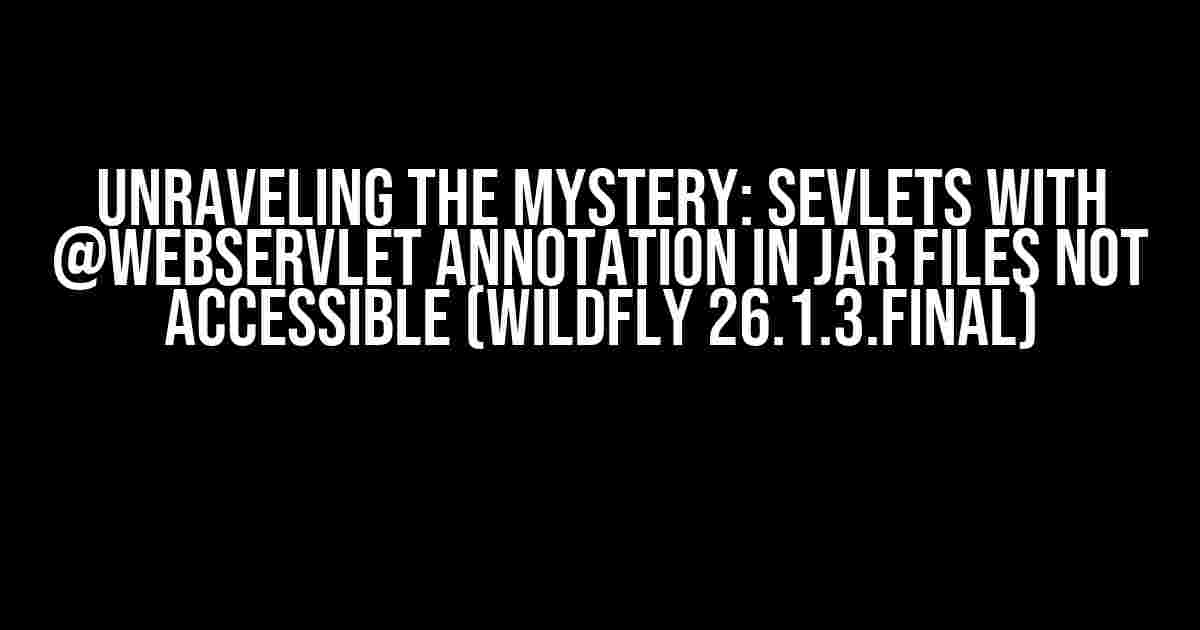Are you stuck in the abyss of Wildfly 26.1.3.Final, struggling to access your Sevlets with @WebServlet annotation packaged in JAR files? Fear not, dear developer, for we’re about to embark on a thrilling adventure to conquer this conundrum together!
The problem: Sevlets in JAR files, inaccessible and invisible
Imagine you’ve created a Sevlet, adorned it with the @WebServlet annotation, and packaged it neatly in a JAR file. You deploy the JAR file to your Wildfly 26.1.3.Final server, expecting it to spring to life and respond to requests with enthusiasm. Alas, your Sevlet remains inaccessible, shrouded in an impenetrable veil of mystery.
Why does this happen? The key lies in understanding how Wildfly handles Sevlets packaged in JAR files. By default, Wildfly doesn’t scan JAR files for Sevlets annotated with @WebServlet. Instead, it relies on a file named `jboss-web.xml` or `web.xml` to discover Sevlets. But fear not, for we have a solution to bypass this limitation!
Solution 1: Using a WAR file instead of a JAR file
The simplest approach is to package your Sevlet in a WAR file instead of a JAR file. Here’s why:
- WAR files are specifically designed for web applications, making them the natural choice for Sevlets.
- Wildfly, by default, scans WAR files for Sevlets annotated with @WebServlet.
- You can include a `web.xml` file in the WAR file’s WEB-INF directory to specify Sevlet mappings.
Here’s an example of a `web.xml` file:
<?xml version="1.0" encoding="UTF-8"?>
<web-app version="3.1" xmlns="http://xmlns.jcp.org/xml/ns/javaee"
xmlns:xsi="http://www.w3.org/2001/XMLSchema-instance"
xsi:schemaLocation="http://xmlns.jcp.org/xml/ns/javaee
http://xmlns.jcp.org/xml/ns/javaee/web-app_3_1.xsd">
<servlet>
<servlet-name>MySevlet</servlet-name>
<servlet-class>com.example.MySevlet</servlet-class>
</servlet>
<servlet-mapping>
<servlet-name>MySevlet</servlet-name>
<url-pattern>/mysevlet</url-pattern>
</servlet-mapping>
</web-app>
Solution 2: Using a custom `servelt-container` in `jboss-web.xml`
If you’re stuck with a JAR file, don’t worry! You can still use a custom `servlet-container` in `jboss-web.xml` to make your Sevlet accessible. Here’s how:
In your JAR file’s META-INF directory, create a file named `jboss-web.xml` with the following content:
<?xml version="1.0" encoding="UTF-8"?>
<jboss-web>
<servlet-container>
<servlet>
<servlet-name>MySevlet</servlet-name>
<servlet-class>com.example.MySevlet</servlet-class>
</servlet>
</servlet-container>
</jboss-web>
This configuration tells Wildfly to scan the JAR file for Sevlets and make them accessible.
Solution 3: Programmatic Sevlet registration
In some cases, you might not be able to use a WAR file or modify the `jboss-web.xml` file. Fear not! You can still register your Sevlet programmatically using the `ServletContext` API.
Create a `ServletContextListener` that registers your Sevlet programmatically:
public class SevletRegisterer implements ServletContextListener {
@Override
public void contextInitialized(ServletContextEvent event) {
ServletContext servletContext = event.getServletContext();
Sevlet mySevlet = new MySevlet();
ServletRegistration.Dynamic registration = servletContext.addServlet("MySevlet", mySevlet);
registration.addMapping("/mysevlet");
}
@Override
public void contextDestroyed(ServletContextEvent event) {
// Nothing to do here
}
}
In your Sevlet class, add the `@WebListener` annotation to register the `ServletContextListener`:
@WebListener
public class SevletRegisterer implements ServletContextListener {
// ...
}
Troubleshooting tips and tricks
Still stuck? Don’t panic! Here are some troubleshooting tips to help you overcome common obstacles:
| Issue | Solution |
|---|---|
| Sevlet not accessible | Check that the Sevlet is properly annotated with `@WebServlet` and that the `url-pattern` is correct. |
| Wildfly not scanning JAR file | Verify that the JAR file is properly deployed to the Wildfly server and that the `jboss-web.xml` file is in the correct location (META-INF). |
| ServletContextListener not called | Ensure that the `ServletContextListener` is properly registered using the `@WebListener` annotation. |
Conclusion
And there you have it, folks! With these solutions and troubleshooting tips, you should be able to access your Sevlets packaged in JAR files using Wildfly 26.1.3.Final. Remember to stay calm, patient, and curious when tackling complex issues.
As the great coding philosopher once said, “A Sevlet is like a ninja – it’s only invisible when you don’t know where to look.”
May the coding force be with you!
Frequently Asked Question
Get to the bottom of the issue with Sevlets with @WebServlet annotation in JAR files not being accessible in Wildfly 26.1.3.Final!
What is the purpose of the @WebServlet annotation in Sevlets?
The @WebServlet annotation is used to declare a servlet and specify its properties, such as the servlet name, URL patterns, and init parameters. It’s a way to configure a servlet without the need for a web.xml file.
Why are Sevlets with @WebServlet annotation in JAR files not accessible in Wildfly 26.1.3.Final?
This is because Wildfly 26.1.3.Final, by default, doesn’t scan for annotations in JAR files. To make it work, you need to add a jboss-deployment-structure.xml file to your WAR file, specifying the JAR file that contains the annotated servlet.
How do I enable scanning for annotations in JAR files in Wildfly 26.1.3.Final?
You can enable scanning by adding the javax.enterprise.api.annotation module to your jboss-deployment-structure.xml file. This tells Wildfly to scan for annotations in JAR files.
What is the role of the jboss-deployment-structure.xml file in resolving this issue?
The jboss-deployment-structure.xml file is used to specify the dependencies and annotations that Wildfly should scan for in your deployment. In this case, it’s used to tell Wildfly to scan the JAR file containing the annotated servlet.
Are there any alternative solutions to using the @WebServlet annotation in JAR files?
Yes, you can use the web.xml file to declare your servlet instead of using the @WebServlet annotation. However, using annotations is often preferred as it’s a more modern and convenient way to configure your servlets.
